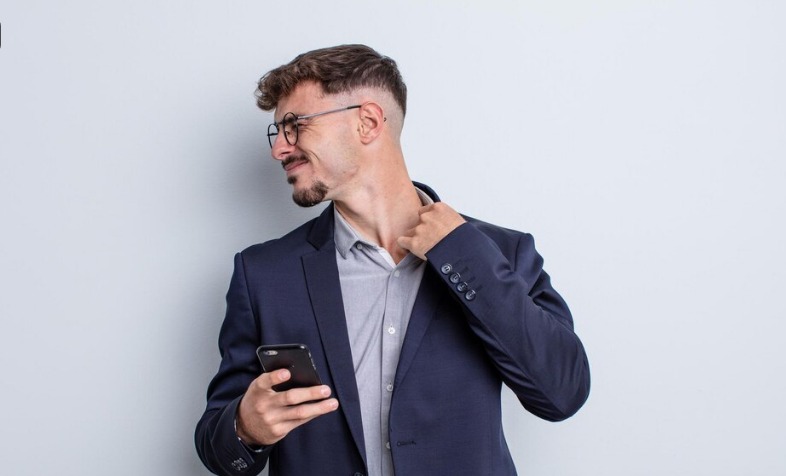Millions of people who spend a lot of time bent over screens suffer from tech neck, a medical condition that is becoming more and more common in our technologically advanced society. The strain from improper positioning when using gadgets like laptops, tablets, and smartphones causes this posture-related condition. Neck pain, stiffness, and more serious issues can develop over time as a result of the repetitive strain of looking down and tilting the head forward. People of all ages, from kids to adults, are now impacted by this illness, which has received a lot of attention lately. Tech neck is a growing concern for everyone who invests time on electronic devices, not just employees in offices and digital enthusiasts, as technology becomes an integral part of everyday life.
The fundamental problem is the head’s abnormal position when using the device. The weight of the average adult head, which ranges from 10 to 12 pounds, places undue strain on the neck muscles and spine when it is held forward for prolonged periods of time. The effects of holding the head at a 45-degree angle are far more harmful than most people realize because it can put up to 50 pounds of pressure on the neck. Even though tech neck might seem like a small annoyance, it can cause a great deal of discomfort and, over time, even long-term damage to the muscles and spine, which can result in headaches, chronic pain, and other problems.
| Attribute | Details |
|---|---|
| Condition Name | Tech Neck (also known as Text Neck) |
| Primary Cause | Prolonged poor posture while using smartphones, computers, etc. |
| Symptoms | Neck pain, stiffness, headaches, soreness, shoulder pain |
| Potential Consequences | Spinal degeneration, disc compression, early-onset arthritis |
| Preventive Measures | Posture correction, ergonomic tools, regular breaks, stretching |
| Common Age Range | Affects individuals of all ages, including children and older adults |
| Famous Cases | Celebrities like Kim Kardashian and athletes are speaking out about tech neck |
| Treatment Options | Physical therapy, pain management, lifestyle changes |
The effects of tech neck are not limited to the general public; numerous celebrities have also taken notice of it. Kim Kardashian, for instance, has publicly discussed her experiences with tech neck, a condition that causes neck pain, despite hours spent on social media and other digital platforms. She once wrote on Instagram about the pain she usually experiences after using her phone for extended periods of time. Similar to this, well-known people like Elon Musk, Selena Gomez, and Meghan Markle have admitted to the physical toll that tech neck takes on them. Due to their high-tech lifestyles, these public personalities have turned into unlikely spokespersons for the illness, which has helped to increase awareness among their sizable fan bases.

Not just the well-known are impacted by the problem. This condition is not unique to athletes, celebrities, or digital influencers. All professions are affected by the rise in tech neck, but office workers are especially affected. An uncomfortable posture is caused by the hours spent hunched over laptops by many people who work from home. The neck, shoulders, and spine can be severely strained by extended use of computers, phones, and tablets without breaks or posture correction. The issue is particularly severe for kids, who spend a lot of time staring down at their gadgets because of online education and entertainment, which can lead to early-stage neck issues.
Workplace cultures have changed significantly as a result of this pervasive problem. Businesses are starting to realize how critical it is to address employee tech neck, especially in light of the growing popularity of remote work. To combat the strain of sitting and staring at screens for extended periods of time, employers are implementing ergonomic solutions, providing standing desks, and urging employees to take regular movement breaks. At the same time, more people are seeking treatment for tech neck from chiropractors and physical therapists. Nowadays, a lot of these medical professionals provide stretching and posture-correction exercises that are especially made to relieve the strain that comes with too much screen time.
Furthermore, medical professionals speculate that the rise in burnout and chronic pain among contemporary workers may be attributed to the epidemic of tech neck. According to studies, one of the main reasons why people miss work is musculoskeletal conditions like neck pain. This is especially true in the tech sector, where spending a lot of time in front of a screen is normal. Businesses are increasingly providing wellness programs to help employees manage the symptoms and keep tech neck from becoming a chronic problem as the condition becomes a bigger concern.
This expanding health issue also affects the entertainment sector. Tech neck can also happen to actors, models, and influencers who spend a lot of time in front of cameras or promoting their work online. In order to draw attention to the problem and motivate their followers to take better care of their necks, some have made their struggles public. As a result, there is a growing need for fitness instructors and posture correction specialists who can assist entertainment workers in maintaining good posture despite their hectic schedules.
There are a number of easy yet efficient ways to help people who are suffering from tech neck. Correcting posture is key. When using digital devices, remaining the screen at level with the eyes and holding the device upright may significantly decrease the strain on the neck. It is crucial to take regular breaks to stand, stretch, and move around in order to keep the muscles from becoming overworked and stiff. In addition, posture-correcting equipment and ergonomic desks and chairs can be especially helpful in fostering proper posture and minimizing discomfort. Stretching techniques that focus on the upper back, shoulders, and neck can help reduce current pain and stop additional strain.
It is imperative to seek medical advice when symptoms worsen or persist. Chiropractors, physical therapists, and other medical specialists can offer specialized techniques to reduce pain and enhance posture. In order to manage the discomfort, more intensive treatments like massage therapy, acupressure, or injections of corticosteroid might be required in some cases. Early intervention is crucial because delaying treatment can lead to long-term health issues that lower quality of life.
